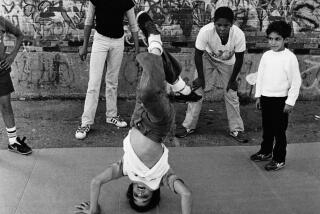After 50 years, Steppin’ ignites cool dance craze
- Share via
CHICAGO — It’s Tuesday at the 50 Yard Line Bar and Grill, and the dance floor is packed with couples twirling and sashaying to the mellow sounds of Barry White, Gerald Levert and other R&B; balladeers.
The dancers are cooler than cool, executing intricate moves best described with one word -- smooth. This is stepping -- Steppin’, if you will -- a distinctive Chicago-bred derivative of swing dancing that is spreading across the country.
Stepping originated in the 1950s as the Bop, taking on its current name around 1990. The dance is a six- or eight-count movement during which partners face each other and clasp hands while alternately moving side-to-side and spinning to the beat. Those are the basics. But stepping is better defined by the individual and improvisational style on display most nights in Chicago and its suburbs, where the dance has had a cult-like following among blacks for more than four decades.
“Stepping is about more than just dancing. It’s a social way of life,” said Herb Kent, a disc jockey at WVAZ-FM and longtime observer of the scene. “Stepping was born here. It probably goes back to the days when jazz was hot and the dances like the Lindy Hop and the Jitterbug were so prominent here.”
With help from R&B; singer and Chicago native R. Kelly, whose current single and video for “Step In the Name of Love” is getting heavy airplay, stepping is now gaining devotees from Washington, D.C., to Atlanta to Los Angeles.
Stepping’s spread doesn’t surprise Pete Frazier, a Chicago impresario who has produced a stepping video and plans to complete a “how to” DVD later this year. “It’s a dance where you don’t have to break a sweat but you can still go out and enjoy yourself because there’s a lot of creativity involved,” said Frazier, 42, a stepper since high school and winner of several contests.
Many top steppers belong to cliques and social clubs that regularly get together at dance parties known as “steppers sets.” Older steppers tend to prefer the more straightforward “original” style while younger dancers lean toward the improvisational “freestyle” form. Others are fans of “walking,” a slower version of stepping.
For 53-year-old grandmother Patricia Gray, Tuesday “is my night to step.” She has been a regular at the 50 Yard Line for the last five years.
“It’s a form of exercise,” Gray said. “My family knows not to bother me on Tuesday because they know where I’ll be.”
Stepping’s exact origins are harder to nail down. From dancers to DJs to organizers of steppers sets, confusion abounds. While it is widely viewed as an offshoot of the Bop, it’s hard to pinpoint how the dance became known as “stepping.”
“It’s like the blues or jazz,” according to Dan Land, 47, who runs a Web site devoted to all things stepping. “You can’t really specify who created it. It’s something that evolved.”
And as other dances emerged and faded from pop culture, the Bop remained on the Chicago scene, Land added. “It would always be around and people would keep changing it,” he said. “In the ‘70s it was called the New Bop and later on, stepping.”
Frazier -- whose dance party billed as the “World’s Largest Steppers Set” drew about 2,000 dancers from Detroit, Atlanta, Milwaukee and elsewhere Labor Day weekend -- also hosts an annual convention in Las Vegas. He hopes that stepping will develop a mainstream following the way salsa dancing has -- a view shared by Land.
“That has always been one of my objectives,” Land said. “It’s a black cultural dance to me and people are beginning to do it all over the country. They may call it Ballin’ [in Detroit] or Hand Dancing [in Washington, D.C.], but regardless of what you call it, it all comes from Chicago.”
More to Read
The biggest entertainment stories
Get our big stories about Hollywood, film, television, music, arts, culture and more right in your inbox as soon as they publish.
You may occasionally receive promotional content from the Los Angeles Times.










